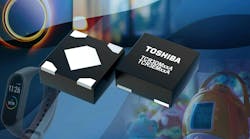300-mA LDO Voltage Regulators Target Space-Challenged Apps
The TCR3DMxxA and TCR3EMxxA series of general-purpose, single-output voltage regulators developed by Toshiba Electronics will find homes in industrial applications or battery-powered systems requiring high-density board assembly. Equipped with an on/off control input, these regulators feature a low dropout voltage and fast transient response.
The devices provide a control pin threshold voltage (VCTH) of 0.8 V (min) and support 1.2-V I/Os, helping to extend the device’s battery life. Both series are housed in the ultra-small DFN4D package (1.0 × 1.0 × 0.37 mm), which enables the use of small ceramic input and output capacitors (≥1.0 µF).
The TCR3DMxxA series can drive up to 300 mA across an input voltage range of 1.5 to 5.5 V and are available in fixed output voltages between 1.0 and 4.5 V (±1%). They offer a very low dropout voltage (typically 216 mV), a low output noise voltage (38 µV RMS), and an excellent ripple rejection ratio (typically 72 dB), enabling the devices to maintain their rated output voltages across a wide range of input battery voltages. The regulators help maximize battery life thanks to their low nominal quiescent current (86 µA) and standby current (0.1 µA).
Able to deliver an output drive of up to 300 mA across their 1.3- to 5.5-V input voltage range, the TCR3EMxxA series of LDO regulators offer fixed output voltages between 0.8 and 5.0 V (±1%). These regulators offer an even lower dropout voltage than the TCR3DMxxA series, 160 mV (2.5 V/150 mA), along with an output noise voltage of 50 µV RMS and a typical ripple rejection ratio of 68 dB. Their ultra-low nominal quiescent current (35 µA) and standby current (1 µA) enables even longer battery life.
Both the TCR3DMxxA and TCR3EMxxA series feature overcurrent protection, thermal shutdown, an inrush-current protection circuit, and an auto-discharge function. A reference design is available for a power-supply circuit application based on the TCR3DMxxA and TCR3EMxxA series LDO regulators.
For more information about new LDO regulators, click here.





